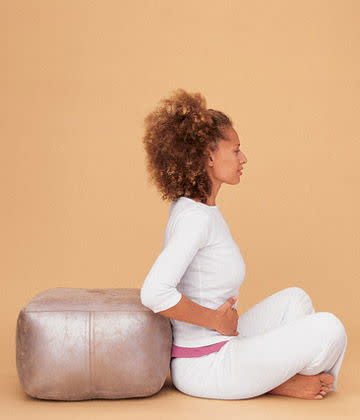Ab Rehab After Pregnancy: The Tupler Technique

After the excitement of bringing your baby home settles into quiet contentment, you might start to notice a bulge in your belly that won't go away no matter how much you exercise and watch your diet.
That protruding belly could be caused by a diastasis, a separation of the rectus abdominis (the outermost abdominal muscle) that sometimes occurs during pregnancy. Unfortunately, the separation doesn't always disappear after you give birth. And left untreated, a diastasis will do nothing to ease the backaches you might continue to have even after your baby is born.
Getting back your abdominal strength is crucial—those muscles support your back and help you avoid the aches and pains of daily activities that come with motherhood. The following program can help. Based on the Tupler Technique, created by New York-based trainer and childbirth educator Julie Tupler, R.N., this unique series of exercises you can do at home will not only protect your back during day-to-day activities, it also will help shrink your belly. Wait until your baby is at least 6 weeks old before starting this or any exercise program. If you've had a Cesarean section, you may need to wait a bit longer; check with your doctor or midwife.
How to Check for a Diastasis
Lie on your back with your knees bent and feet flat on the floor. With your fingers pointing down toward your feet, hold your hand flat on your belly. Press your fingers down as you slowly lift just your head off the floor. You may feel a gully between the midline of your body; that's a diastasis. If you have one, you should use a splint when doing back lying exercises such as head lifts. To do so, take a strong scarf or piece of fabric that is about 62 inches long and 6 inches to 9 inches wide (towels are too thick; splints are sold at diastasisrehab.com). Wrap the cloth flat around your lower back, holding an end in each hand. Cross the ends and pull from both sides toward the middle and hold.
The Tupler Technique Workout
It's not only important to breathe correctly when you exercise, it's also important to learn how to properly draw in your abdominal muscles before any activity, such as picking up your baby. By doing so, you use the transversus abdominis (aka the transverse), the innermost muscle that wraps around your abdomen and back like a corset. Strengthening the transverse protects your back and gives your belly a flatter appearance. The basis of the Tupler Technique is isolating the transverse.
Here's how: The action of the transverse is front to back. Imagine your transverse is a sideways elevator with six floors. Take a deep breath through your nose as you expand your belly (fully expanded is the "first floor") and fill your lungs. Exhale through your mouth and empty your lungs as you contract your transverse muscle back toward your spine to the "sixth floor" (a count of six). Hold this position before you do any exercise moves and/or activities, such as getting out of bed or lifting groceries. For more information, go to diastasisrehab.com.
Sit cross-legged with your back against a support, shoulders in line with your hips, and both hands on your abdomen. Inhale, expanding your belly out to the first floor, then exhale as you bring your transverse back to the fifth floor.
Hold and count out loud to 30. Do 5 small squeezes toward the sixth floor (as far toward the back of your spine as possible), then end with 1 full breath. Repeat 10 times.
Benefit: Strengthens abdominals.
In the Elevators position, place one hand under your ribs and one below your navel. Inhale, expanding your belly out to the first floor, then exhale to bring the transverse to the third floor, keeping your shoulders still; this is the starting position.
Count out loud as you bring the transverse back to the fifth floor. Squeeze and hold there, bringing your ribs together. (This is 1 repetition.) Bring the transverse back to the third floor and repeat. Work up to 100 reps 3–5 times per day.
To progress: After 2 weeks, you can work from the fourth to fifth floor and then from the fifth to sixth floor.
Benefit: Strengthens abdominals, especially the transverse.
Stand with your knees bent, legs hip-width apart, hands on thighs, and rest your upper-body weight on your arms. Flatten your back, draw your transverse in to the fifth floor and pull your pubic bone toward your navel, pointing your tailbone down.
Hold for a count of 5, then return to the flat-back position. Do 10 tilts.
Benefits: Strengthens abdominals and stretches lower back.
Lie on your back with your knees bent, feet flat on the floor and close to your buttocks. Inhale to expand your belly, then exhale to bring your transverse to the fifth floor, placing the small of your back on the floor (If you have a diastasis, use a splint; see "How to Check for a Diastasis"). Lift your head only, bringing your chin toward your chest.
Hold your transverse in as you inhale and bring your head down to the floor. Do 10 head lifts.
Benefit: Strengthens abdominals.
Lie on your back with your knees bent, feet flat on the floor, close to your buttocks. Place one hand on your belly and the other under the small of your back, palm up. Hold your transverse in at the fifth floor and bring your knees up over your hips.
Slide your heel back toward your buttocks, then lift it to the starting position. Switch legs.
Do 15 alternating slides (30 total). If you can't hold your transverse in, wait until you feel strong enough to try this exercise.
Benefit: Strengthens abdominals.
Lie on your back with your arms straight, knees bent, feet flat on the floor and heels close to your buttocks.
